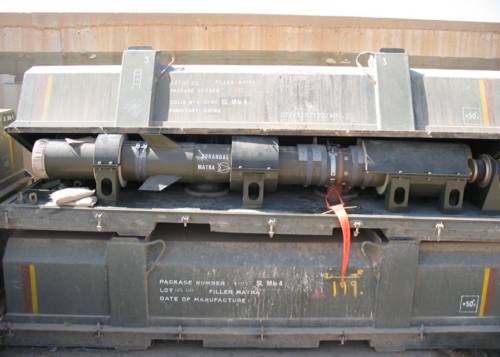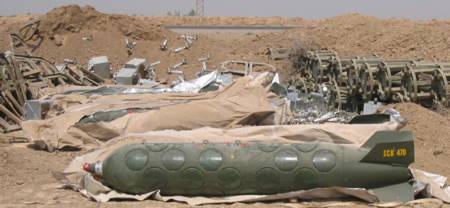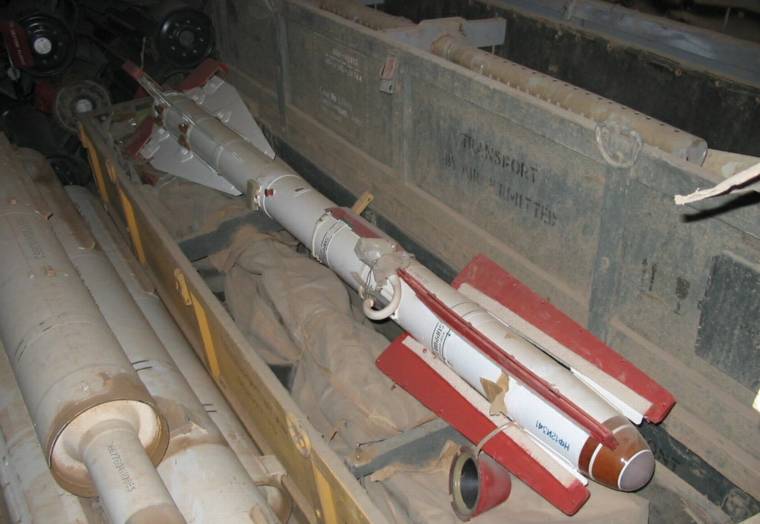e. magill's Intrigue | |||
| Back | |||
Proof of Iraqi Possession of Illegal Munitions from France, Russia, and South Africa?I came across a story on Newsmax, a highly partisan news agency, concerning prohibited weapons found in Iraq, manufactured as recently as 2001 and imported into Iraq from places like France and Russia. There are six pictures included with the story. [1]The first picture is one of a Durandal bomb [2], a parachute-retarded timed explosive specifically used to destroy runways, and the design characteristics make it easy for anybody who knows about these munitions to tell that it is, in fact, a Durandal. Durandals are manufactured in France. They were used by the U.S. during the first Gulf War, so it is conceivable, depending on when the bomb was manufactured, that it came from the United States at that time. However, from the picture supplied on the Newsmax website, one cannot get a completely clear read of the date of manufacture and the Newsmax article claims that the bomb was manufactured within the last few years.
The second picture is of French-made bomb fuses. Newsmax claims that the packing slip gives a manufacture date of Jan. 5, 2001, although I can't really read it. I can tell, though, that the bag pictured, containing the fuses, has French writing on it, and the fuse itself has Arabic writing on it. The third picture is an up-close look at the fuse, and, indeed, most of the writing is some form of Arabic. However, scrawled in blue are some numerals, including the number "2001". Is this an unaltered manufacture date or just a pathetic attempt to fake one? The fourth picture is, quite indisputably, a Russian AA-8 air-to-air "Aphid" missile [3]. While there is no indication of a manufacture date, the missile appears to be quite new. In the fifth picture, you can see box dispensers with Russian KMGU bombs inside (in the background). KMGUs are 500 to 1000-kg cluster bomb containers made and used solely by Russia. The last picture is clearly that of an SCB470 cluster bomb; you can even see the designation on the rear dorsal fin. It should be noted that, while Blix didn't mention it in his oral address to the U.N., his written declaration of March 6, 2003, refers to South African cluster bombs that Iraq was modifying for dispersal of chemical weapons [4, 5].
Now, a word about cluster bombs. They are filled with small and colorful fragmentation bomblets that typically have a high "dud" ratio (something around 10%). They are designed to send out metal shrapnel that rips through human flesh and causes concussion waves throughout the body, waves that can rupture organs that are nowhere near the impact site. Because of their high "dud" ratio, they can lie around long after they were deployed, waiting for an unsuspecting child to come near them, awed by the colorful little balls, at which time it can unexpectedly explode. Their use is extremely controversial (for the record, I am firmly against it), but they have been used by the United States and others in many wars, including this year's invasion of Iraq. [6, 7, 8] Getting back to the Newsmax pictures, though, if they are indeed from Iraq and were taken as recently as they are purported to have been taken, then this is evidence that Iraq was in violation of numerous U.N. resolutions, including 1441. There are no mentions of these munitions anywhere in Iraq's declaration, and there is no legal reason that Iraq should have possessed them. While I cannot clearly make out the manufacture dates, the source insists that these weapons were all manufactured very recently, which suggests that they came into Iraq during the inspections blackout between 1998 and 2002. Importing weapons, especially prohibited weapons, is very clearly forbidden by several U.N. resolutions. The fact that these weapons came from countries that very vocally opposed a military incursion into Iraq (and countries that headed, controlled, and monitored inspections) raises a huge red-flag of suspicion. Do I believe that these pictures are indisputable evidence of anything? No, but I find them hardly surprising and I find them to be very important for anyone who believes that Iraq was not in violation of the U.N. to see. I also believe that these pictures are but the tip of a giant iceberg. And, if they do point a finger of suspicion at France, Russia, and even South Africa, it is to be expected that this kind of news would not appear on the national wire. If there is evidence that any major allied nation was covertly supplying munitions to Iraq, then many governments would not want that information leaked to the press and, if it were, these governments would probably hand down strict mandates that the information be kept under wraps (as the U.S. government did with the nuclear centrifuge recently uncovered in Iraq--no major American news outlet reported the centrifuge until weeks after it learned about it, because all of the major outlets were waiting for an administrative green-light).
I'm not saying these pictures prove anything. In fact, I find them to be suspect for a number of reasons: 1) the source, while not known for lying, is inexcusably partisan, 2) you cannot prove that the manufacture dates are as recent as Newsmax indicates or that the pictures are even recent, 3) you cannot prove the pictures are from Iraq, and 4) nobody else has mentioned them. I offer this to you as just something to think about and nothing more, but I will say that, from the point of view of somebody who has been researching Iraq's history of weapons programs, these pictures, if genuine, are nothing compared to the totality, aside from evidence that France and Russia have some explaining to do. If France and Russia have supplied munitions to Iraq in violation of the U.N., it explains their hesitancy to move on Iraq and it outlines the inherent flaw of the multilateral body. How can any governmental organization that lacks oversight, accountability, and a system of checks and balances be considered incorruptible? What reason do we have to trust any stand taken by its members (including the U.S.)? Just a thought. (This list does not represent the entirety of my research on this subject) -e. magill, 10/23/2003 | |||
| Copyright ©2003 e. magill. All rights reserved. |


